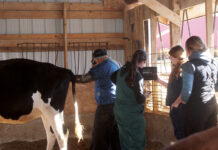WOOSTER, Ohio — Open field and high tunnel tomato producers yearning for high-quality crop performance with marketable fruit neatly wrapped in one plant may find what they are looking for through grafting.
Ohio State University researchers with the Ohio Agricultural Research and Development Center“>Ohio Agricultural Research and Development Center have found success in using the technique to improve tomato production.
“We chose tomato because it is susceptible to a number of field stresses, very important economically, and responds to grafting,” said Matt Kleinhenz, an Ohio State University Extension vegetable crops specialist.
“Still, other crops such as cantaloupe, watermelon and cucumber can also be grafted. So, what is learned with tomato grafting may also apply to these crops.”
Why not?
Until now, grafting has been reserved for the green industry and hydroponic vegetable production, but Kleinhenz thinks that open field and high tunnel tomato producers would also employ the technique.
“Grafting and high tunnels may be an especially popular combination. The scale, economics and typically fixed-in-place nature of high tunnel production are such that high tunnel users may readily include grafted plants in their routine.”
Like greenhouse producers, high tunnel users must squeeze every dime out of every square foot of semi-controlled space they manage, added Kleinhenz.
“Grafting fits well as a tool in these systems and many open field systems as well.”
Creating hardier plant
Grafting is a technique whereby the root system of one plant (rootstock) is fused onto the foliage of another plant (scion).
Typically, the rootstock roots resist soilborne disease more effectively than the natural roots of the scion, and may also be more vigorous or scavenge nutrients and/or water more effectively. However, the rootstock variety usually does not produce marketable fruit — that is the responsibility of the scion variety.
And it’s the combination of the two varieties that may work to the grower’s and, ultimately, to the consumer’s benefit.
“Consumers may prefer the fruit of Variety A but that variety may have deficiencies such as poor disease resistance or high water or nutrient needs. On the other hand, Variety B produces undesirable fruit but is more disease or stress tolerant. Growers and consumers aim for crops to be produced as responsibly as possible. So, combining Varieties A and B may be an effective and responsible choice,” said Kleinhenz.
“Grafted plants may require less pesticide, fertilizer and/or water to remain healthy and productive.”
Faster research
Researchers are finding that grafting may improve varieties more quickly and efficiently compared to traditional genetic breeding.
“Breeding a new variety that is superior to others in many ways is best but very challenging. It usually involves give and take, time, specific skills and other resources,” said Kleinhenz.
“Grafting combines the best features of two varieties directly and instantly with, we believe, less compromise and more upside for all involved.”
Ironically, when grafting succeeds, it opens the door for more breeding because of the need for more commercial rootstocks and scions, he added.
Grafting also opens the door to using varieties previously thought to have little value given their weaknesses.
Kleinhenz and his colleagues are now entering their third year of the three-year project. OARDC researchers are collaborating with researchers from the University of Minnesota, West Virginia State University, North Carolina State University and Penn State.
On-farm tests
Farmers have also contributed significantly to the project from the beginning and continue to test the performance of grafted plants on their farms.
“Overall, we have shown that grafted tomato plants can out-perform ungrafted ones (especially when soilborne disease and low soil moisture are present), identified strategies for overcoming obstacles to the use of grafted plants, and helped educate people to prepare grafted plants for themselves or others,” said Kleinhenz.
Cultivars studied
For the project, researchers genetically bred 46 rootstocks and grafted them to the tops of two popular tomato cultivars: ‘Cherokee Purple‘ and ‘Celebrity’.
They then compared field and high tunnel grafted tomatoes to non-grafted tomatoes and found that in both production systems, grafted tomatoes out-yielded non-grafted tomatoes anywhere from 5 percent to 30 percent.
The yield increases were greatest in the presence of soil-borne diseases and in drought conditions. In addition, researchers found that the chemical make-up of grafted fruit was indistinguishable to non-grafted fruit, meaning that the characteristics consumers use to measure a good fruit remained unchanged.
Finally, researchers found that grafted tomatoes had a higher productivity during the course of the season. The plants were large and healthy despite, in some cases, having not been fertilized (which is especially good news for organic producers), said Kleinhenz.
Still more research
Three grafted rootstocks out of the 36 tested were found to produce the best results and researchers will study them one more year before recommending them for potential commercial development.
There are several commercial rootstocks available, but only two that have grown in popularity: Maxifort and Beaufort. Adding new commercial varieties to the market should give growers interested in grafting more options.









